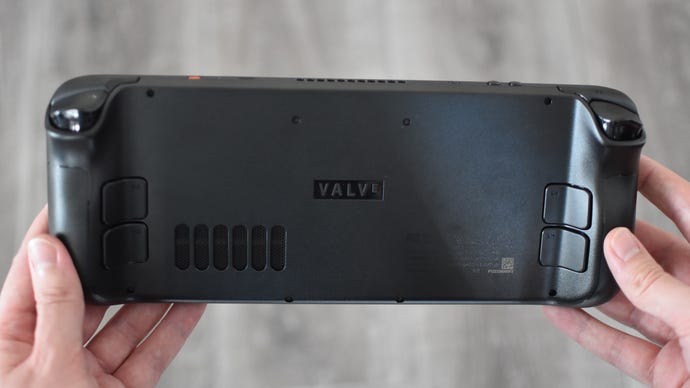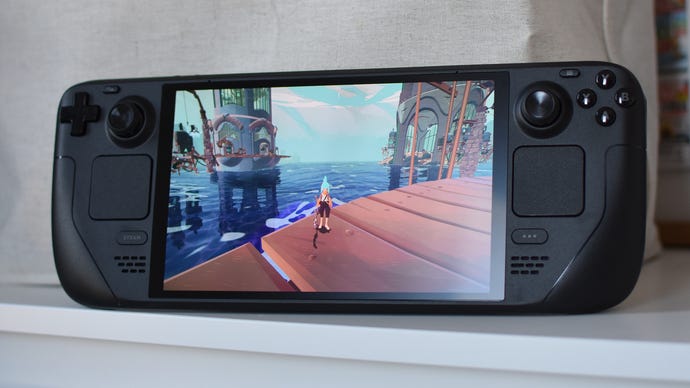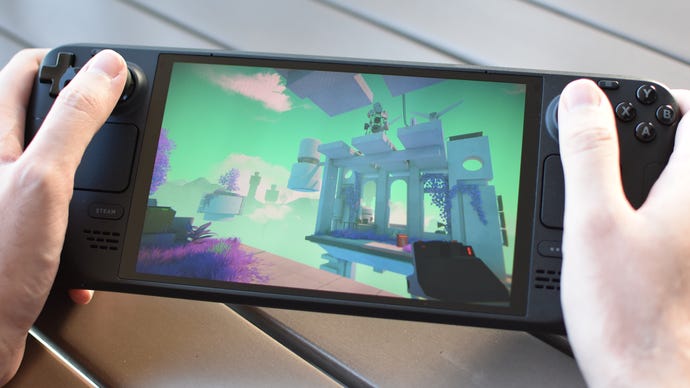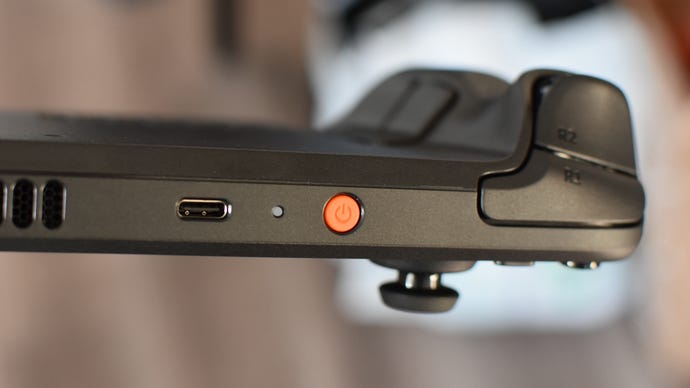I didn’t know the Steam Deck OLED existed till final week, and but it’s primarily one thing I’ve wished for practically two years. As nice a handheld gaming PC as the unique Steam Deck is, its barely bland IPS show and quick battery life are some particular weak factors – factors to which newer, shinier rivals, such because the Asus ROG Ally and Lenovo Legion Go, have been glad to use stress.
Valve are eager to emphasize that this OLED-equipped mannequin represents an replace, not an entire generational switcheroo. But there’s a lot, way more behind that display that just a few totally different diodes. This can be a lighter, brighter, longer-lasting, typically even faster-running tackle the SteamOS handheld, and one which sneaks in some shock upgrades as typically because it addresses points with the unique Steam Deck. I adore it.
Watch on YouTube
Very first thing’s first, although. The Steam Deck OLED’s new show retains the 1280×800 decision of the usual Deck, however expands the property barely, upping diagonal measurement from 7in to 7.4in. For the reason that Steam Deck OLED’s outer dimensions stay unchanged, save for gaining 1mm of top from the brand new thumbsticks, this has the welcome facet good thing about consuming into these beforehand large bezels.
It’s clear and clean in movement, particularly in video games that may shift frames quick sufficient to use the heightened 90Hz refresh fee – one other step up from the unique 60Hz Deck display, even when it doesn’t match the ROG Ally’s 120Hz. Nonetheless, as with OLED gaming screens, the principle causes you’d swap to this panel tech from IPS are color efficiency and brightness, and this panel delivers on each.
Breaking out the colourimeter, I measured sRGB gamut protection at 93.8% on the Steam Deck OLED, a mahoosive enchancment on the unique’s 63.7%. In easy phrases this implies the OLED model can show a wider array of colors, permitting for extra element and better vibrancy. Since all OLED screens can show good, inky blacks, distinction was additionally recorded at Infinity:1 – the usual Steam Deck wasn’t dangerous on distinction, hitting 1241:1, however you may’t beat infinity in a numbers recreation.
As for brightness, there isn’t actually a distinction in commonplace dynamic vary (SDR) visuals, the place the Steam Deck OLED peaked at 606cd/m2. That’s virtually an identical to the unique show’s 596cd/m2 consequence. Nevertheless, the Steam Deck OLED additionally provides excessive dynamic vary (HDR) help, so can roast your retinas much more successfully: in Cyberpunk 2077, considered one of many HDR-capable video games, I recorded peak brightness rising to 984cd/m2, solely simply shy of Valve’s marketed most of 1000cd/m2.

Spared the technical wobbliness that accompanies HDR utilization on Home windows, I discovered myself having fun with its advantages way more readily on the Steam Deck OLED. And why would you not? It actually makes video games look higher. You’ll be able to see in these Ratchet & Clank: Rift Aside pictures that with out HDR, the solar’s bloom impact overpowers all the display, leaving a lot of it trying washed-out. With HDR, the solar itself is brighter, however the lighting impact is extra managed, leaving deeper, richer colors all through.
These have been each snapped on the Steam Deck OLED, and the show high quality distinction is even starker when in comparison with an OG Steam Deck. With each previous and new Decks operating F1 22, the OLED model’s superior distinction and color selection helps to carry out particulars that may be misplaced in any other case.

Let’s not gloss over that 90Hz refresh fee, both. The Steam Deck may be extra of a 30fps service provider the place large, fats, AAA works are involved, however there are a great deal of video games that had beforehand bumped up in opposition to the efficient 60fps cap of the unique. Right here, they’ll run free and clean, perhaps even gaining a number of extra frames per second from the refreshed APU.
Earlier than you get too excited: this mixed CPU/GPU is constructed for effectivity, not efficiency. All different issues being equal, the AMD Ryzen Z1 Excessive that powers each the ROG Ally and Legion Go will nonetheless beat it in a straight FPS footrace. Even so, I discovered it might assist a teensy bit with sub-60fps video games. Cyberpunk 2077, operating on its Steam Deck preset, averaged 45fps on the unique Steam Deck and 47fps on the Steam Deck OLED. Horizon Zero Daybreak, on Unique settings and with High quality-level FSR upscaling, rose from 54fps to 57fps in an analogous method. And Shadow Of The Tomb Raider did notably nicely for itself, rising from 51fps to 56fps on its Low preset. Murderer’s Creed Mirage was much less fortunate, although, solely gaining a single further body with 42fps on Low.
Once more, these aren’t (nor supposed to be) main enhancements. It’s that greater refresh fee that’s the true efficiency assist, as demonstrated by F1 22 on Low high quality. This might run at a strong 60fps on the previous Steam Deck, however couldn’t go any sooner with that 60Hz refresh fee. On the Steam Deck OLED, the identical high quality settings produce 86fps on common, as a result of the show isn’t clipping the sport’s wings. Certain, extra demanding video games received’t profit, however loads of others will, and I for one discover Portal 2’s shooty puzzling markedly extra snug at a gentle 90fps.

You could possibly nonetheless rely the brand new APU as a major improve, due to its profitable tuning of the Steam Deck OLED’s energy effectivity. Moreover the clearly handheld-critical battery life implications (we’re attending to that quickly, promise), this mannequin runs noticeably cooler than earlier than, and for the reason that followers doesn’t must work as laborious, it’s quieter too. Beneath gaming load, I measured the 2 hottest spots on the rear of the Steam Deck OLED – simply above the vents, and simply to the facet of the L4/L5 buttons – at 31°c and 28°c respectively. On my first-gen-as-first-gen-can-be Deck, the identical spots have been 42°c and 33°c. Fan noise, in the meantime, maxed out at 58db on the unique Steam Deck, and 52db on the Steam Deck OLED. Sooner, cooler, and quieter: not a lot to complain about right here.
The entire system, in reality, feels simply that little bit extra refined. Possibly not a lot with the ostentatious orange energy button (for optimum flashiness, there’s a $679 Particular Version with translucent casing), however there are some extra sensible touch-ups. For one, the Steam Deck OLED is 29g lighter than the unique Steam Deck, thanks partly to the display itself being thinner and lighter than the previous IPS panel. This doesn’t sound like a lot, however there’s certainly a tangible distinction within the arms. Elsewhere on the within, Valve have added Wi-Fi 6E help, so you would get sooner recreation downloads in case your router is as much as spec (mine, uh, isn’t).

The thumbsticks are new as nicely, and really feel a lot grippier within the centre; I fairly like wrapping my unique Steam Deck in rubbery thumbstick covers, however don’t actually really feel the necessity on the Steam Deck OLED. Valve have additionally tweaked the touchpad haptics, I believe for the higher – the extra constant clickiness of the vibration helps it really feel extra like spinning the bezel on a pleasant watch and fewer like thumbing a pillowcase filled with irate hornets. Even the Phillips-head screws that held the Steam Deck’s backplate in place are changed by Torx screws, that are extra resilient in opposition to stripping. Assuming, that’s, you continue to need to ignore Valve’s recommendation in opposition to taking the backplate off in any respect.
For all these little changes, although, nothing concerning the Steam Deck OLED has as elementary an influence on its day-to-day doings because the battery life upgrades. These are impressively broad: the battery itself is larger, up from 40Whr to 50Whr, but it surely’s additionally getting assist from the APU’s effectivity enhancements, in addition to the OLED display itself. Don’t fret an excessive amount of concerning the greater refresh fee carrying down the battery sooner, because it’s the panel expertise that basically makes the distinction right here, and OLED merely makes use of much less power than IPS. Particularly in very darkish scenes, the place lots of the LEDs could merely be switched off.

The deeply pleasing result’s that the Steam Deck OLED can last as long as 50% longer than the earlier mannequin, and typically much more. Precise totals nonetheless fluctuate by recreation, however with the comparatively slow-draining ones, you would match a whole worldwide flight contained in the added uptime. Portal 2 is a positive instance: this lasted for 4h 03m on the unique Steam Deck, with display brightness and speaker quantity each set to 50%. On the identical settings, the Steam Deck OLED saved going to 5h 48m, practically two hours longer.
(I do know you’d see sooner draining in HDR video games that may use extra of the 1000 out there nits, however since we’ve established that SDR peak brightness is almost an identical on each gadgets, I caught to 50% brightness in SDR mode to maintain the comparisons honest.)
In additional battery-hungry video games, the positive factors aren’t as nice, although they’re nonetheless vital. Possibly extra so, given their unique struggles. The Elder Scrolls V: Skyrim solely managed 1h 44m on the unique Steam Deck, however the Steam Deck OLED might get it nicely over the 2h mark – 2h 15m, to be exact. Horzion Zero Daybreak additionally climbed up from 1h 31m to 2h 15m, whereas Murderer’s Creed Mirage stretched from a miserly 1h 23m all the way in which to 2h 12m.
Possibly we’re nonetheless a number of years off with the ability to cost our handheld PCs each few days, fairly than after each session. However, take it from somebody whose 2022-spec Steam Deck has run out of juice extra instances than a Hebridean orchard: when some video games take lower than a few hours to empty a full battery to flat, an additional half-hour goes to really feel like a protracted, very long time certainly. And, as soon as the Steam Deck OLED does go dry, it could recharge sooner as nicely, courtesy of its rejigged energy provide. After an hour of charging from zero, the Steam Deck OLED had reclaimed 69%, excess of the 48% that the unique Steam Deck and its plug might produce in the identical time. The brand new energy provide additionally provides a metre of cable size, making the hand held simpler to play whereas recharging in case your seat isn’t proper subsequent to a handy mains socket.

It truly is simply improve upon improve upon improve, and whereas the Steam Deck OLED will price greater than the IPS Deck when it releases on November sixteenth, that’s virtually completely as a result of the latter is getting hefty worth cuts. If something, while you take onboard space for storing under consideration, the 2 new OLED variants are literally higher worth than the pre-cut originals.
A 512GB Steam Deck OLED, for instance, will price £479 / $549, lower than the £569 / $649 that the unique 512GB Deck was for many of its life. The 1TB OLED mannequin – oh, yeah, there’s a 1TB Steam Deck now – is definitely the one which matches that £569 / $649 worth, whereas providing the practically twice the storage. Even figuring out that the previous 512GB mannequin is falling to £389 / $449 (whereas shares final), and it’s laborious to have a look at the Steam Deck OLED’s myriad enhancements and never contemplate it a extra enticing bundle. Even the aforementioned Steam Deck OLED Particular Version doesn’t appear to be a lot of an extravagance, at $679, although it’s unique to the US and Canada in the intervening time.
If there are disappointments available with the Steam Deck OLED, I can consider simply two. First, the shortage of a ‘finances’ 256GB or 64GB possibility, and second, the 2 1TB fashions get some goodies that the 512GB model doesn’t. There’s no anti-glare coating on the smaller mannequin’s display, regardless of it coming as commonplace on the unique 512GB Deck, and it doesn’t include the neat new carrying case that the 1TB fashions do both. However then, the £90 / $100 you’d save on the 512GB OLED can very feasibly cowl each an honest third-party case and a 512GB microSD card, to get your complete space for storing as much as parity.

Personally, if I have been a potential shopper of positive SteamOS handhelds, I would go for the brand new one in a blink. The Steam Deck OLED not solely directs its focus to the 2 largest shortcomings of the unique, however takes the time to shine up design particulars and construct high quality to the purpose the place you may actually really feel its superiority. If Valve are proper in {that a} Steam Deck with actually next-gen efficiency continues to be a number of years away – and in hindsight, they’ve been very explicit with mentioning the efficiency bit – then I’m more than pleased to cross the time on this OLED model.
This assessment relies on a retail pattern of the 1TB Steam Deck OLED supplied by Valve.
